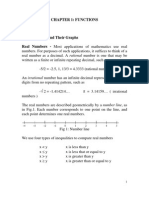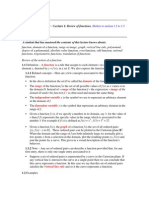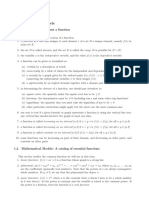Ch2 Functions
Uploaded by
Betty BavorováCh2 Functions
Uploaded by
Betty BavorováTaken from Haese Mathematics:
Mathematics for the international
student: Mathematics SL
Chapter 2
Functions
Alzbeta Bavorova
Ch2 Functions
Relations and functions
A relation consists of ordered pairs showing the relationship
between two variables. It is a set of points relating the two
variables.
The domain of a relation are all possible values on the
horizontal (x) axis.
The range of a relation are all possible values on the vertical (y)
axis.
Relations are often expressed through equations. However,
some relations cannot be expressed through equations.
All these are relations:
Functions
A function, sometimes called a mapping, is a relation in which no two different ordered pairs have the x-
coordinate or first component. This means that there is only one y value for every x value.
A function is a special type of relation.
Algebraic test:
If a relationship is given as an equation, and the substitution of any value for x results in one and only one value
of y, then the relation is a function
Geometric test / Vertical line test:
If we draw all possible vertical lines on the graph of a relation, the relation is a function if each line cuts the
graph once at most.
Function notation
f: x 2x + 3 f(x) = 2x + 3 y = 2x + 3
All the above are valid function notations.
This is the Cartesian plane.
It is named after the French philosopher
Ren Descartes.
y = f(x) is called the function value or the image of x.
Linear functions
A linear function has the general formula f(x) = ax + b, where a and b are real constants. The graph of a linear
function is a straight line.
a slope of the function
b y intercept of the function
Domain and range
The domain of a relation are all possible values on the horizontal (x) axis.
The range of a relation are all possible values on the vertical (y) axis.
The domain and range are often described using set notation:
Examples:
domain: {x | x -1 } {x | x } {x | x 2}
range: {y | y -3}
Number line graphs
Number line graphs are used to illustrate the domain and range.
Domain and range of functions
If a domain is not defined, we use the natural domain, that is the largest part of , for which f(x) is defined.
Remember that:
=> x 0
=> x 0
Composite functions
(f g)(x) is the composite function of functions f and g. This means, that the function g is substituted for x
within function f.
f(x) = x
4
g(x) = 2x + 3
(fg)(x) = (2x+3)
4
(gf)(x) = 2x
4
+ 3
The domain of the composite function depends on the domain of the original function. It will only include what
the domains of both the functions included.
Sign diagrams
See chapter1: quadratics.
When you encounter a dotted line on a sign diagram, this means that the function is undefined for the given
value (It is excluded from the domain).
Remember:
For functions f(x) = x
A
:
if A is even, there is no change of sign (it is a parabola, such as for x
2
).
if A is odd, there is a change of sign (such as x
3
).
Rational functions
When we divide a linear function by another linear function, we get a rational function (Rational functions are
called rational, because they can be expressed through a
fraction, just like rational numbers).
They take the form of a hyperbola and are characterized by
asymptotes.
This chapter only deals with rectangular hyperbolas, whose
asymptotes are parallel to the x and y axes.
Reciprocal function
A reciprocal of a number is the number to the power of -1. This means that a reciprocal of x = x
-1
=
1
.
Reciprocal functions represent indirect proportionalities.
The numerator in this fraction does not contain x.
Its horizontal asymptote is equal to the x-axis (for vertical, see below).
Rational functions in the form =
+
+
,
Compared to the previous example, this function will be a shifted rectangular parabola.
ASYMPTOTES:
The vertical asymptote is easy x will equal whatever is excluded from the domain. This means that you have
to calculate cx + d = 0 for x.
The horizontal asymptote is more difficult. To determine it, consider how the function will behave as |x|
approaches infinity. There are two methods:
1. Method A
Substitute very large and very small numbers for x. You can try
() =
2 +1
1
(1000) =
2001
999
2.003
(1000) =
1999
1001
1.997
From this we can see that the horizontal asymptote x = 2.
This method is easy, but quite imprecise (and unmathematical). It is the one the textbook shows.
2. Method B
(http://www.purplemath.com/modules/asymnote.htm)
() =
2 +1
1
(2 +1) ( 1) = 2
(2 2)
3
() = 2 +
3
1
=> The horizontal asymptote: = 2
This method is more precise and mathematical, but may be slightly more difficult.
Sometimes, you get equations that are already in the final form, though! For those, this method is very
fast and easy.
Writing about asymptotes
If asymptotes x = 2 and y = 1, we can say that:
x 1
-
, y - (as x approaches 1 in the bottom half of the graph, y approaches negative infinity)
x 1
+
, y (as x approaches 1 in the top half of the graph, y approaches positive infinity)
Inverse functions
+ and
and
2
and
Inverse functions are also just like inverse operations. One undoes what the other one did.
The inverse function of f(x) is denoted as f
-1
(x). Dont confuse this with reciprocals!
(ff
-1
)(x) = x and (f
-1
f)(x) = x.
Remember that not all functions have inverse
functions. Be sure to do the vertical line test once you
come up with an inverse function.
Inverse functions are always symmetrical along x = y
with the original function.
If (x, y) lies on f, then (y, x) lies on f
-1
.
The domain of f is equal to the range of f
-1
and vice
versa.
Any function, whose inverse is the very same function is called a self-inverse function. Such function must be
symmetrical along x = y. (x = y and
1
are both self-inverse)
How to find f
-1
: = +
1. Substitute x for y
1
: = +
2. Rearrange so that you have y on one side and the rest of the other.
1
:
1
: =
3. Do the horizontal line test, to check whether
1
is indeed a function. If not, state that f has no inverse
function.
All these are inverse operations - one undoes what the other one did!
You might also like
- Geometry EOC Practice Test Solutions (Complete)No ratings yetGeometry EOC Practice Test Solutions (Complete)41 pages
- De La Salle University Ramon V. Del Rosario College of BusinessNo ratings yetDe La Salle University Ramon V. Del Rosario College of Business5 pages
- A Catalog of Essential Functions: Linear ModelsNo ratings yetA Catalog of Essential Functions: Linear Models27 pages
- FUNCTIONS_6bf5bb85-965f-440e-a69d-f2d2869ed80eNo ratings yetFUNCTIONS_6bf5bb85-965f-440e-a69d-f2d2869ed80e40 pages
- Tuesday September 13: (Refers To Section 1.2 To 1.5 in Your Text)No ratings yetTuesday September 13: (Refers To Section 1.2 To 1.5 in Your Text)4 pages
- College and Advanced Algebra Handout # 1 - Chapter 1. FunctionsNo ratings yetCollege and Advanced Algebra Handout # 1 - Chapter 1. Functions8 pages
- Section 3.4 Rational Functions: Example 1No ratings yetSection 3.4 Rational Functions: Example 118 pages
- Mathematical Techniques For Economic Analysis: Australian National University DR Reza HajargashtNo ratings yetMathematical Techniques For Economic Analysis: Australian National University DR Reza Hajargasht60 pages
- 1.3 Support 1 - Absolute Value Functions: High School Differential Calculus CourseNo ratings yet1.3 Support 1 - Absolute Value Functions: High School Differential Calculus Course3 pages
- Domain and Range of A Function Math 8 Unit 2 Week 4 Module 1 Equal or Less 10 PagesNo ratings yetDomain and Range of A Function Math 8 Unit 2 Week 4 Module 1 Equal or Less 10 Pages9 pages
- MTH 135 - Toan Giai Tich Cho Y-Duoc - 2020S - Lecture Slides - 1-1No ratings yetMTH 135 - Toan Giai Tich Cho Y-Duoc - 2020S - Lecture Slides - 1-144 pages
- 1 Functions As Models: 1.1 Four Ways To Represent A FunctionNo ratings yet1 Functions As Models: 1.1 Four Ways To Represent A Function3 pages
- Training Course 9 Senior Functions and TrigonometryNo ratings yetTraining Course 9 Senior Functions and Trigonometry32 pages
- Public Choice (Not Only Politics!) : Median Voter ModelNo ratings yetPublic Choice (Not Only Politics!) : Median Voter Model2 pages
- Cells: Assesment Statements From Pearson Baccalaureate HL BiologyNo ratings yetCells: Assesment Statements From Pearson Baccalaureate HL Biology16 pages
- Elasticity: Price Elasticity of Demand (PED)No ratings yetElasticity: Price Elasticity of Demand (PED)2 pages
- Maximum Material Boundary (MMB) and Its Advantages in GD&T Analysis PDFNo ratings yetMaximum Material Boundary (MMB) and Its Advantages in GD&T Analysis PDF6 pages
- Physics 11th Sample Question On System of PariclesNo ratings yetPhysics 11th Sample Question On System of Paricles2 pages
- silo.tips_applications-of-tensor-analysisNo ratings yetsilo.tips_applications-of-tensor-analysis7 pages
- (一页一张PPT)GCSE-CircleTheorems - for EllaNo ratings yet(一页一张PPT)GCSE-CircleTheorems - for Ella36 pages
- Glencoe Homework Practice Workbook Geometry Answers Key50% (2)Glencoe Homework Practice Workbook Geometry Answers Key4 pages
- Sine Rule, Cosine Rule and Area of Triangle WS Answer-RevisionNo ratings yetSine Rule, Cosine Rule and Area of Triangle WS Answer-Revision6 pages
- Junior Science Talent Search Exam. (2014-2015) Subject: Mathematics100% (3)Junior Science Talent Search Exam. (2014-2015) Subject: Mathematics6 pages
- Maths Class X Sample Paper Test 02 For Board Exam 2024 AnswersNo ratings yetMaths Class X Sample Paper Test 02 For Board Exam 2024 Answers13 pages
- Trigonometry Came From Three Greek Words, Tri Which Means Three, Gono Which MeansNo ratings yetTrigonometry Came From Three Greek Words, Tri Which Means Three, Gono Which Means1 page
- 04 - Crystallogaphy III Miller Indices-Faces-Forms-EditedNo ratings yet04 - Crystallogaphy III Miller Indices-Faces-Forms-Edited63 pages
- Clase Práctica Funciones y Modelos CuadráticosNo ratings yetClase Práctica Funciones y Modelos Cuadráticos17 pages
- (Ebook) Lectures on the Geometry of Manifolds (Third Edition) by Liviu I Nicolaescu ISBN 9789811214813, 9811214816 - The ebook in PDF format with all chapters is ready for downloadNo ratings yet(Ebook) Lectures on the Geometry of Manifolds (Third Edition) by Liviu I Nicolaescu ISBN 9789811214813, 9811214816 - The ebook in PDF format with all chapters is ready for download74 pages
- Full Solutions 2018: Mathematics Paper 2No ratings yetFull Solutions 2018: Mathematics Paper 214 pages
- De La Salle University Ramon V. Del Rosario College of BusinessDe La Salle University Ramon V. Del Rosario College of Business
- Tuesday September 13: (Refers To Section 1.2 To 1.5 in Your Text)Tuesday September 13: (Refers To Section 1.2 To 1.5 in Your Text)
- College and Advanced Algebra Handout # 1 - Chapter 1. FunctionsCollege and Advanced Algebra Handout # 1 - Chapter 1. Functions
- Mathematical Techniques For Economic Analysis: Australian National University DR Reza HajargashtMathematical Techniques For Economic Analysis: Australian National University DR Reza Hajargasht
- 1.3 Support 1 - Absolute Value Functions: High School Differential Calculus Course1.3 Support 1 - Absolute Value Functions: High School Differential Calculus Course
- Domain and Range of A Function Math 8 Unit 2 Week 4 Module 1 Equal or Less 10 PagesDomain and Range of A Function Math 8 Unit 2 Week 4 Module 1 Equal or Less 10 Pages
- MTH 135 - Toan Giai Tich Cho Y-Duoc - 2020S - Lecture Slides - 1-1MTH 135 - Toan Giai Tich Cho Y-Duoc - 2020S - Lecture Slides - 1-1
- 1 Functions As Models: 1.1 Four Ways To Represent A Function1 Functions As Models: 1.1 Four Ways To Represent A Function
- Training Course 9 Senior Functions and TrigonometryTraining Course 9 Senior Functions and Trigonometry
- A-level Maths Revision: Cheeky Revision ShortcutsFrom EverandA-level Maths Revision: Cheeky Revision Shortcuts
- Public Choice (Not Only Politics!) : Median Voter ModelPublic Choice (Not Only Politics!) : Median Voter Model
- Cells: Assesment Statements From Pearson Baccalaureate HL BiologyCells: Assesment Statements From Pearson Baccalaureate HL Biology
- Maximum Material Boundary (MMB) and Its Advantages in GD&T Analysis PDFMaximum Material Boundary (MMB) and Its Advantages in GD&T Analysis PDF
- Physics 11th Sample Question On System of PariclesPhysics 11th Sample Question On System of Paricles
- Glencoe Homework Practice Workbook Geometry Answers KeyGlencoe Homework Practice Workbook Geometry Answers Key
- Sine Rule, Cosine Rule and Area of Triangle WS Answer-RevisionSine Rule, Cosine Rule and Area of Triangle WS Answer-Revision
- Junior Science Talent Search Exam. (2014-2015) Subject: MathematicsJunior Science Talent Search Exam. (2014-2015) Subject: Mathematics
- Maths Class X Sample Paper Test 02 For Board Exam 2024 AnswersMaths Class X Sample Paper Test 02 For Board Exam 2024 Answers
- Trigonometry Came From Three Greek Words, Tri Which Means Three, Gono Which MeansTrigonometry Came From Three Greek Words, Tri Which Means Three, Gono Which Means
- 04 - Crystallogaphy III Miller Indices-Faces-Forms-Edited04 - Crystallogaphy III Miller Indices-Faces-Forms-Edited
- (Ebook) Lectures on the Geometry of Manifolds (Third Edition) by Liviu I Nicolaescu ISBN 9789811214813, 9811214816 - The ebook in PDF format with all chapters is ready for download(Ebook) Lectures on the Geometry of Manifolds (Third Edition) by Liviu I Nicolaescu ISBN 9789811214813, 9811214816 - The ebook in PDF format with all chapters is ready for download


































































































